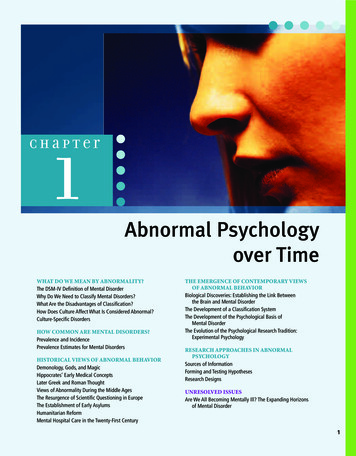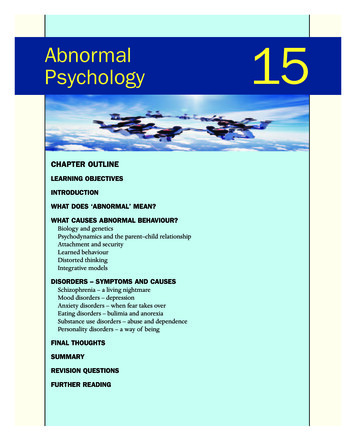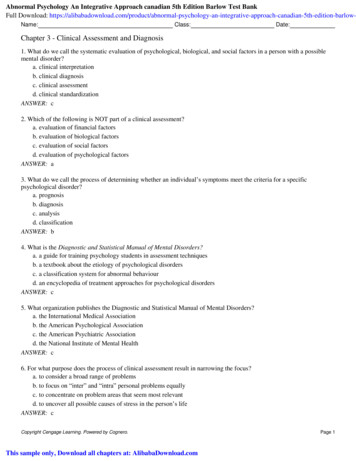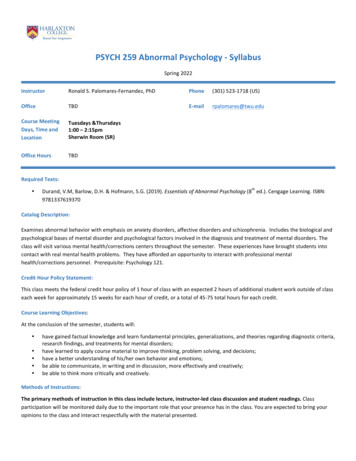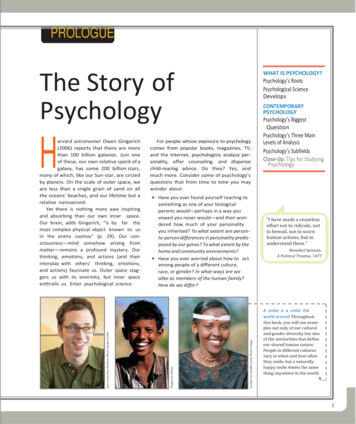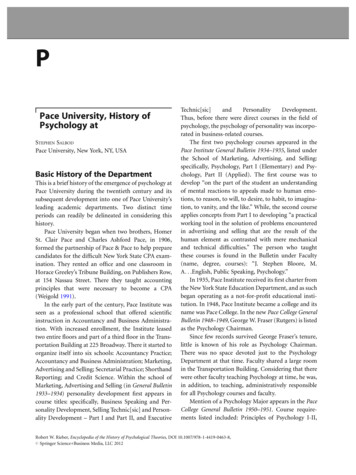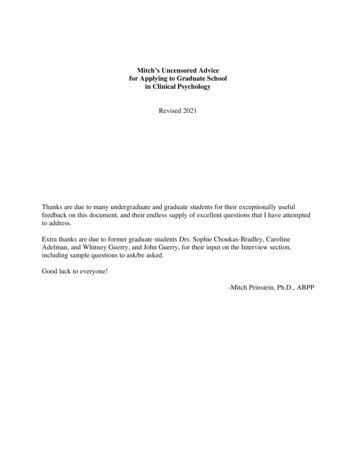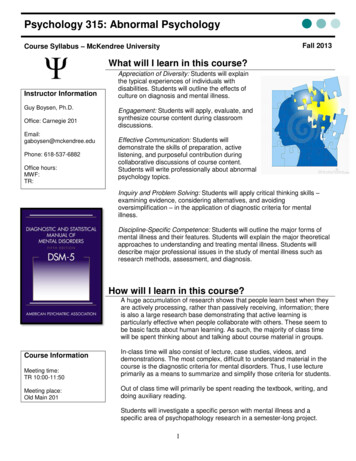
Transcription
Psychology 315: Abnormal PsychologyCourse Syllabus – McKendree UniversityFall 2013What will I learn in this course?Instructor InformationGuy Boysen, Ph.D.Office: Carnegie 201Email:gaboysen@mckendree.eduPhone: 618-537-6882Office hours:MWF:TR:Appreciation of Diversity: Students will explainthe typical experiences of individuals withdisabilities. Students will outline the effects ofculture on diagnosis and mental illness.Engagement: Students will apply, evaluate, andsynthesize course content during classroomdiscussions.Effective Communication: Students willdemonstrate the skills of preparation, activelistening, and purposeful contribution duringcollaborative discussions of course content.Students will write professionally about abnormalpsychology topics.Inquiry and Problem Solving: Students will apply critical thinking skills –examining evidence, considering alternatives, and avoidingoversimplification – in the application of diagnostic criteria for mentalillness.Discipline-Specific Competence: Students will outline the major forms ofmental illness and their features. Students will explain the major theoreticalapproaches to understanding and treating mental illness. Students willdescribe major professional issues in the study of mental illness such asresearch methods, assessment, and diagnosis.How will I learn in this course?A huge accumulation of research shows that people learn best when theyare actively processing, rather than passively receiving, information; thereis also a large research base demonstrating that active learning isparticularly effective when people collaborate with others. These seem tobe basic facts about human learning. As such, the majority of class timewill be spent thinking about and talking about course material in groups.Course InformationMeeting time:TR 10:00-11:50Meeting place:Old Main 201In-class time will also consist of lecture, case studies, videos, anddemonstrations. The most complex, difficult to understand material in thecourse is the diagnostic criteria for mental disorders. Thus, I use lectureprimarily as a means to summarize and simplify those criteria for students.Out of class time will primarily be spent reading the textbook, writing, anddoing auxiliary reading.Students will investigate a specific person with mental illness and aspecific area of psychopathology research in a semester-long project.1
What will I need for this course?Required textbooksBarlow, D. H., & Durand, V. M. (2012). Abnormal psychology: An integratedapproach. (6th ed.). Belmont, CA: Thompson Wadsworth.Barlow, D. H., & Durand, V. M. (2013). DSM-5 supplement.Additional readingsCaspi et al., (2003). Influence of life stress on depression: Moderation by apolymorphism in the 5-HTT gene. Science, 301, 386-389.Freud, S. (1909). Five lectures on psycho-analysis. In J. Strachey (Ed. &Trans.), The standard edition of the complete psychological works ofSigmund Freud (Vol. 11, 9-55). London: Hogarth Press. (First lectureONLY, pp 9-20).Howes et al., (2007) Street slang and schizophrenia. British Medical Journal,335, 1294. doi:10.1136/bmj.39413.798472.BESlutske et al., (2004). Do college students drink more than their non-collegeattending peers? Evidence from a population-based longitudinal femaletwin study. Journal of Abnormal Psychology, 113, 530-540. doi:10.1037/0021-843X.113.4.530Szasz, T. (1960). The myth of mental illness. American Psychologist, 15,113-118.Wakefield, J. C. (1992). The concept of mental disorder: On the boundarybetween biological facts and social values. American Psychologist, 47,373-388.The course Blackboard webpage is an essential component of the course.How will I be graded?Quizzes (6 x 20 points)Cumulative Final ExamCase history paperCase analysis paperPrep guides (4 x 13)Team Assignments (4 x 10)CollaborationTOTAL 120 points 50 points 36 points 90 points 52 points 130 points 30 points 487 pointsSpaced practiceRepetitionPractice testingGrading Scale: 93% A, 90% A-, 87% B , 83% B,80% B-, 77% C , 73% C, 70 C-, 60% D, 60% FThinking ofmeaningCollaborationHow should I prepare for classes?Look over the course schedule and complete all readings and assignmentsdue that day of class. Do this at least the day before class so that you havetime to complete in-depth reseedings and assignments.Prepare for team assignments in class by bringing a printed copy of youranswers to that day’s prep guide questions, which are found on Blackboard.How do I know what I am supposed to learn?There is no mystery in this class in terms of what students need to know or how they are evaluated.Detailed learning objectives are posted on Blackboard and should be printed out for use in reading andstudying for quizzes. Detailed rubrics outlining how papers are graded are also available on Blackboard.2
How will team-based learning and assignments work?Prep GuidesThe purpose of the prep guides is to allow students to be ready for collaborative learning in class. Therelevant learning objectives are listed at the top of the prep guides. Thus, prep guides also allowstudents to focus their preparation for class using the course learning objectives.TaskThe prep guides can be found on Blackboard. Each prep guide will consist of a slightly different task,but they will all be based on a specific reading and require written answers to several questions.Answers should be written using complete sentences, using a professional tone, and citing any sourcesthat are used outside of the texts assigned for class.GradingPrep guides are due as listed on the course schedule. Each one is worth 4 points. Complete, wellwritten, that show good effort to provide accurate answers will receive a score of 4. Failure to meet anyof one of these expectations will result in a score of 2, and failure to meet any two of these expectationswill result in a score of 1. Because these assignments are specifically designed to prepare students forteam collaboration in class, late prep guides will not be accepted.Team AssignmentsTeam assignments provide students with the opportunity to work with others in understanding coursematerial. Students have difficulty with certain concepts can receive help form their team members, andteam members with more complete understanding can learn even better through assisting others.Teams also offer a unique opportunity to learn from others’ perspectives on very interesting topics(suicide, orgasms, and drugs just to name a few).TaskStudents will be part of three assigned teams over the course of the semester. Teams will collaborateon in-class assignments. One team member will record group answers, and all group members willreceive the same grade based on that one assignment.GradingAssignments are worth 10 points each and must be completed during class time. Full credit can beearned if there is one incorrect answer on the group assignment. Each subsequent incorrect answer willresult in the loss of two points. Students who do not turn in a prep guide will receive no credit for theteam assignment for that day.Collaboration GradeTeam members are expected to attend meetings, listen, contribute, move the group toward taskcompletion, and maintain a professional attitude. In order to reinforce these behaviors, teams willanonymously evaluate each team member’s contributions. I will use these ratings in my assignment of acollaboration grade. Students will receive a grade out of 10 points for each of their teams throughout thesemester.How will I be tested?Students often find this surprising, but testing is a highly effective method of learning. Time spendtesting oneself leads to more learning than time reviewing. Think about flash cards and you get the idea.Based on this research, there will be many quizzes rather than big tests. Also, students should preparefor these quizzes by testing their ability to accomplish learning objectives without using the book ornotes.Quizzes3
There will be 6 quizzes and one comprehensive final exam. All questions on the quizzes will requirewritten answers. Each of the quizzes will consist of two parts. First, there will be a short answer andessay portion generally covering the course learning objectives. Second, students will make a diagnosiswith supporting rationale for a fictional case. Short answer will be worth 10 points, and the diagnosis willbe worth 10 points.Material on the quizzes will be based only on the learning objectives covered since the last quiz.Learning objectives that are organized by quiz are available in the Course Materials section of thecourse Blackboard webpage. Each quiz will start at the beginning of the class period and last for 25minutes. Students who arrive late to class will not be allowed extra time on the quiz.Final ExamResearch shows that students learn more when courses have cumulative finals and retain what theylearn for longer; thus, there will be a cumulative final. The final exam will follow the same format as thequizzes, but there will be three cases and 20 short answer points leading to a total value of 50 points.What should I be working on for the case analysis project?The case anlaysis project is a semester-long research and writing assignment that will allow students tobecome experts on a particular subject of psychopathology that is of interest to them. Students will writea case history on a famous person or character with a mental disorder. Then, students will provide aconceptualization of the subject from their case history. Finally, they will also read and synthesizeresearch related to their case. The project will help students develop (a) writing skills, (b) critical thinkingskills, (c) and psychology-based knowledge, which are all components of the McKendree UniversityMission.Following the techniques of good writing, the assignment involves several incremental steps outlinedbelow. I highly suggest that students read over the sections on the bibliography, the outline, and thefinal paper before beginning the assignment.Step 1: The Case HistorySubjectA famous person or character from television, film, literature, or history must be selected. The persondoes not need to have been actually diagnosed with a mental disorder, but a strong case should be ableto be made for the existence of one. Two papers will be written about this person; thus, choosingsomeone personally interesting and with a well-documented life is advantageous. Possible (unoriginal)ideas for people include Sheldon Cooper, Mort Rainy, Patty Duke, John Nash, Monk, Melvin Udal,Karen Carpenter, Marilyn Monroe, van Gogh, and Tyler Durden.FormatPapers should be 3 pages maximum (double spaced, 12-point font, 1-inch margins). APA style shouldbe used with regard to professional language and proper crediting of sources. Any sources that areused should be cited, and this includes the textbook. Only one quote can be used in the paper.SectionsPart 1: Case history. Report on the person’s personal history focusing on the significant factors relatedto mental disorder. The focus of this section is on exploring aspects of the person’s life that might relateto the disorder; do not simply write a short biography. Three areas must be covered. One, discussbiological factors such as family history of mental disorder, medical problems, or brain disorders. Two,discuss psychological factors such as personality, unconscious conflict, cognitive styles, defensemechanisms, learning experiences, or psychological trauma. Third, discuss social factors such as familyhistory, social relations, or cultural influences. All three areas need to be covered, and exemplarypapers will include more than one factor in each area (e.g., personality and learning in the psychologicalarea rather than just personality). If there is no information on an area, the reason for this omission mustbe stated explicitly.4
Part 2: Signs and symptoms of mental disorder. Report all of the signs and symptoms of the mentaldisorder that the person exhibits. Signs and symptoms are found in the DSM criteria for mentaldisorders in the text. Although it is not necessary to copy DSM criteria exactly, I should be able toidentify which criteria the person meets from the description of symptoms. If the person does not meetthe required criteria exactly, make a case for why he or she should still receive the diagnosis. Thediagnosis must be comprehensive for all behavior presented in the paper. If undiagnosed signs andsymptoms are presented, explain why that disorder was not diagnosed.Part 3: Diagnosis. A complete DSM diagnosis should be given for the person. List the diagnosis andhow the person meets the criteria. Please pick a specific point in the person’s life in order to make thediagnosis rather attempting to assign a diagnosis for their whole life.GradingPapers will be worth 30 points. Grading is based on a rubric posted under Course Materials onBlackboard. An example of a high-quality paper is also available on Blackboard under Course Materials.Rough and final drafts are due to as listed on the syllabus. Both drafts should be submitted to theSafeAssign dropbox, but I only need a hard copy of the final paper. The late penalty is one half lettergrade for every day overdue. Rough drafts are worth 6 points – two for each section of the paper. Laterough drafts will not be accepted.I am available to read rough drafts of papers. Please send them to me electronically, and I will makecomments on them using the Track Changes function in Word. I will not read papers that have not beenproofread for spelling, grammar, and general clarity of writing.Step 2: The Case ConceptualizationTopicThe purpose of the case conceptualization is to explain the mental disorder of the character from thecase history. Choose a specific model of psychopathology (psychodynamic, biological, behavioral,cognitive, integrative, or another orientation with my approval). Summarize the important aspects of themodel. Also, conceptualize the case by using the model to explain how the person’s disorder originatedand is maintained. Assume that the reader knows nothing about the particular model.FormatFormatting is the same as for the case history paper.GradingPapers will be worth 30 points. Grading is based on a rubric posted under Course Materials onBlackboard. A hard copy and a submission to the SafeAssign dropbox are due to as listed on thesyllabus. I will read and provide feedback on the conceptualizations, but they will be treated as drafts ofthe final paper; thus, they will be worth 4 points – two for each section. Late drafts will not be accepted.Step 3: Annotated BibliographyThe purpose of the annotated bibliography is to allow students to identify and evaluate sources relatedto a thesis. Students should search the scientific literature and find at least 8 sources related to theircase history. The sources should focus on a very narrow topic related to the case such as an etiologicalmodel, prevention, a treatment method, assessment, associated controversies, or future status in theDSM. Sources may only include scholarly journals and books – these materials are found in the librarycatalog or through a library electronic database such as PsychINFO. In addition, the sources shouldmostly focus on the last few decades of research on abnormal psychology.Develop a thesis statement using the sources. Thesis statements offer a conclusion that can besupported with evidence. The articles in the bibliography will be the evidence. Example of a thesisstatement include: “Specialized testing reliably distinguishes real dissociation from faked dissociation, ”5
and “Exposure and response prevention is an effective treatment for obsessive compulsive disorder.” Athesis should be very specific and cover a very narrow topic.FormatBibliographies must contain (a) a thesis statement, (b) the APA style citation for each source, and (c) abrief summary of how each source supports the thesis. If the thesis is narrow enough, these statementsmay be very similar for the articles.GradingBibliographies are due as listed on the course schedule. Students should submit the bibliography beforeclass to the dropbox found under the Assignments tab on Blackboard. I will read and provide onlinefeedback on the bibliographies, but they will receive no grade. Rather, failure to turn in an acceptablebibliography will result in a full letter grade reduction in the paper’s final score. I will judge a bibliographyto be unacceptable if it fails to meet any two of the format requirements outlined above.Part 4: Literature Review OutlineThe purpose of the outline is to help student organize their thoughts for the paper before writing therough draft.FormatThe outline should be written in formal language using complete sentences. Main points should beorganized using bullets or letters/numbers to indicate their relative importance. Only the literature reviewand application sections need to be outlined (see Final Paper section below). For the literature reviewsection, the first sentence should be the thesis statement. Subsequent sentences should represent themain points supporting the thesis. The main points should include citations in parentheses to indicatesources. Finally, include an APA style reference section with the cited sources listed alphabetically. Atleast 5 sources are required.GradingOutlines are due as listed on the course schedule. Grading will be the same as for the annotatedbibliography.Part 5: Final Case Analysis PaperThe final paper will bring together all parts of the project into one complete anlaysis.FormatPapers should be approximately 8-12 pages (double spaced, 12-point font, 1-inch margins). APA stylewith regard to professional language and proper crediting of sources should be used. The paper mustinclude a reference section and indicate where sources are used in the text by using citations placed inparentheses. The textbook and course readings such as Slutskie et al. (2004) provide excellentexamples of how to reference and cite in APA style. Only one quote can be used in the paper. Links toAPA style guides are also available in Blackboard.SectionsIntroduction. The introduction should preview the content and purpose of the paper in several ways.Briefly describe the person and diagnosis that was the focus of the case history. State the theoreticalorientation used to conceptualize the case. Provide a thesis statement related to the literature review.Case History and Conceptualization. These sections should include the revised versions of thepreviously submitted assignments.Literature review. Building off the research done for the annotated bibliography, review a very narrowarea of scholarly literature related to your case. At least 5 scholarly sources are required. Include anintroduction to the literature review section that (a) previews the material to come, (b) introduces key6
issues and/or defines key terms, and (c) restates the thesis. The body of the review should make pointsto support the thesis; these points should be supported with citations of scholarly sources. Organize thereview by building logical arguments to support the thesis; do not simply summarize articles in noparticular order. The literature review need not relate directly to the model used on the conceptualizationsection.Application. This section integrates the literature review and the case history. Explain the specificinsights that can be gained about the case from the literature review by applying the science in thereview to the case. To provide just a sample of possible applications: if the review was about treatment,explain how the treatment would be conducted with the person from the case; if the review was aboutetiology, apply that etiology to explain the case; if the review was about a controversy, explain how thecase supports or refutes the controversial arguments.Conclusion. Signal the end of the paper with a conclusion. The conclusion section should (a) summarizemajor points, (b) connect ideas from separate sections of the paper, and (c) provide a final message forreaders.GradingThe paper is worth 75 points. The grading rubric can be found under Course Materials on Blackboard.Rough and final drafts of the paper are due as listed on the course schedule. Both drafts should besubmitted to the SafeAssign dropbox, but I only need a hard copy of the final paper. The penalty forlate papers is one half letter grade for every day overdue. Rough drafts are worth 5 points – two foreach new section of the paper and one for the introduction and conclusion. Late rough drafts will not beaccepted.What other course policies do I need to know about?AttendanceAttendance is mandatory for all class periods. Assignments and tests completed in class cannot bemade up unless an excused absence is documented in writing.Plagiarism and Academic HonestyAs outlined in the college catalog, students must conduct themselves with academic integrity andhonesty. All forms of cheating and plagiarism constitute violations of academic honesty. Plagiarism isusing the ideas or words of others without giving proper credit to the source. Students who plagiarizetend to (a) take just a few words or ideas from a source without giving credit, (b) use the exact words ofa definition, (c) change some, but not all, key words when paraphrasing. Use of exact words from asource requires three steps to avoid plagiarism. First, quotation marks must be placed around thewords. Second, the source must be identified. Third, the page number must be given. For example:Mental illness is best conceptualized as a “harmful dysfunction” (Wakefield, 1999, p. 1). Internet links toAPA style guides are posted in the Course Materials section of the course Blackboard webpage.However, the textbook serves as a perfect example of how to cite and reference resources.NondiscriminationAppreciation for diversity is one of the foundational aspects of the McKendree University Mission. Inaddition, the Student Handbook states that “McKendree University does not discriminate on the basis ofrace, religion, gender, ethnic background, age, disability, sexual orientation, or gender expression.” Thisclass follows the same policy, and any failure to maintain these standards should be brought to myattention.Mental illness is stigmatized. In order to reduce that stigma, please maintain an attitude of respect forpeople with disorders. Refrain from using pejorative slang such as crazy, nuts, schizo, and psycho. Wewill talk about disorders and people with disorders. Disorders are simply labels applied to people. Assuch, please refer to “people with a disorder” rather than disordered people. For example, use “peoplewith schizophrenia” rather than “schizophrenics.”7
Distraction-Free Environment PolicyHumans can hold 7 2 items in their memory and can actively work with only about half of those items atone time. Attention is a limited resource and dividing attention leads to poor information processing andlearning. As such, this class will be distraction free. Distracted students – primarily those usingelectronic devices – will be asked to leave class and return when they are ready to focus. The policyextends to exams, but during exams I will ask students using electronic devices to leave, I will assumethey are cheating, and I may submit a formal charge of academic dishonesty.Students With DisabilitiesA student requiring assistance with the technical portions of the course should contact the Instructor orthe Academic Support Center. Services for Students with disabilities are provided through theMcKendree Academic Support Center in order to help the student integrate in the entire collegeexperience. MASC provides coordination and implementation of special accommodations for studentswith documented disabilities.What do these marks mean on my mmar. Check the grammar. Read the sentence out loud to hear the error.Not a sentence. The sentence is not complete; it is missing a subject or a verb.Punctuation. The use of punctuation is wrong.Awkward. The phrasing is cluttered, inelegant, or clumsy. Read the phrase out loud andthink of less awkward phrasing.Informal. The writing is too informal – e.g., slang, contractions, conversational tone, useof “you.”Clarify. The point is not clear. I do not know what you are trying to communicate.Transition. You have jumped from one topic to another without connecting them. Youshould provide a clear bridge from the first topic to the second.Proofing error. You have missed a typo, misspelling, or other basic error that should becaught in proofreading.Organization. The structure of the paper is not clear. Ideas are not being presented in anorder that makes sense.Off topic. The reason you are talking about the topic is not clear. It does not seemconnected to the surrounding material.New paragraph. Start a new paragraph. The ideas that follow are a new topic worthy ofits own section in the paper.Development. Expand the section or idea. Include more sentences if the paragraph has less than 3.8
What will we be doing when? (a tentative plan)DateTopicReadingT 8/27R 8/29IntroductionDefinitions; DSM diagnosisT 9/3Models of psychopathologyR 9/5T 9/10R 9/12T 9/17R 9/19T 9/24Anxiety disordersContinuedContinuedSomatoform and dissociative disordersContinuedContinuedR 9/26T 10/1R 10/3Mood disordersContinuedContinuedCh 7T 10/8Eating disordersCh 8 (pp. 262-283)R 10/10ContinuedT 10/15R 10/17Sexual and gender identity disordersContinuedT 10/22R 10/24ContinuedSubstance and impulse control disordersCh 11T 10/29ContinuedSlutske et al., 2004R 10/31T 11/5R 11/7T 11/12R 11/13T 11/19Personality disordersContinuedContinuedSchizophrenia and psychotic disordersContinuedContinuedCh 12R 11/21T 11/26Developmental disordersContinuedCh 14, Ch 12 (pp. 448-449)R 11/28NO CLASSWakefield, 1992; Ch 3 (pp. 8595)Ch 1, Ch 2, Cognitive TherapyVideoCh 5AssignmentPrep Guide 1Prep Guide 2Quiz 1Prep Guide 3Ch 6Freud, 1910Caspi et al., 2003Prep Guide 4Prep Guide 5Quiz 2Prep Guide 6Case HistoryDraftCase HistoryFinalPrep Guide 7Quiz 3Ch 10Ch 13Howes et al., 2007CaseConceptualizationPrep Guide 8Quiz 4Prep Guide 9BibliographyPrep Guide 10OutlineQuiz 5Prep Guide 11Case AnalysisDraftPrep Guide 12Case Analysis Final9
T 12/3R 12/5T 12/11LegalMyth of mental illness debate10:30-12:30Ch 16;Szasz, 196010Quiz 6Prep Guide 13Final Exam
Psychology 315: Abnormal Psychology Course Syllabus . Out of class time will primarily be spent reading the textbook, writing, and doing auxiliary reading. . Barlow, D. H., & Durand, V. M. (2013). DSM-5 supplement. Additional readings Caspi et al., (2003)
